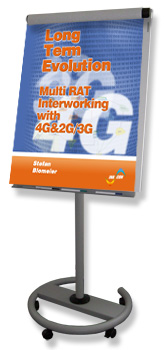 LTE Multi-RAT
LTE Multi-RAT
Interworking with 4G & 2G/3G
 Training Course Description
Training Course Description

- This course focuses on the inter-system operation between the new EPS and the legacy GSM/UMTS networks and explains how major CS services are supported in LTE.
- We highlight how legacy voice call is supported in EPS through either CSFB or VoIP-IMS or VoLGA and how SMS via SGs-interface (CS-based) or SMS over IP-IMS are possible.
- One aspect of this course is to explain how NAS has to behave in Multi-RAT environment during iRAT reselections and handovers .
- Further this course points out the functionality of Idle Signaling Reduction and UE's priority-based cell reselection among GERAN, UTRAN and E-UTRAN using Subscriber Profile ID, the SPID for RAT/frequency priority parameters
- Inter-system changes between the RAT's can be basically performed in two ways, either seamless using handovers with minimum service interruption time, or alternatively relying on more or less advanced iRAT reselections, starting from RRC Connection Release with Redirection Info, Cell Change Order and Network Assisted Cell Change.
- Handovers between the RAT's are the preferred choice for delay critical services like voice (SRVCC-Handover from LTE to GERAN or UTRAN) requiring the highest degree of interoperability between UE, EPS and GERAN/UTRA, however, more cost-effective for non real-time services are Redirections, Cell Change Order and to a certain extend Network Assisted Cell Change procedures.
- In practice this means the operator has to decide when and how to configure Measurement Gaps in E-UTRAN or Compressed Mode in UMTS for inter-RAT measurements. In EGPRS the focus is on features like NACC, alternatively PS-Handover and DTM and how they are beneficial not only for the subscriber but also for the operator's business case.
- In order to get to know the LTE signaling and its parameters, the course starts with a solid description about E-UTRAN's air-interface, and particular how resources get allocated through the master control channel using various Downlink Control Information's (DCI's).
- Further the course analyzes the RRC Signaling in E-UTRAN for example how Handovers and Measurements Configurations are signaled or how a UE drops when being out-of-sync.
- Great emphasis is put on the layer 1 measurements of the other RAT when preparing for handover. Particularly the course focus on IRAT neighbor scanning and Pilot measurements when UE is in LTE or UMTS or GERAN connected mode.
As in all our training courses, we integrated several interactive exercises for a perfect learning experience.
 Some of your questions that will be answered
Some of your questions that will be answered
- What is the legacy GERAN/UTRAN Architecture requiring the UE to support NMO-1, 2 or 3?
- How can ISR help in reducing the Routing and Tracking Area Updates?
- How could the Paging Success Rate be improved with LAC/RAC Harmonization in GERAN/UTRAN?
- What are the differences between Network Operation Modes in GERAN/UTRAN and UE Operation modes in EPS?
- What are the advantages for subscriber and operator when the UE performs prioritized Cell Reselection compared to ordinary offset based Reselection?
- What is the difference between dedicated and common prioritizes for Inter Frequency and Inter-RAT's neighbors?
- How can a Voice call be supported in EPS and how to ensure Service Continuity between different RAT's
- Is SMS in roaming situations still supported in EPS via SGs-interface? And how does SMS over IMS work?
- How many PDP Contexts should a GERAN/UTRAN network support in order to compete with the number of possible EPS Bearers in LTE/SAE?
 Who should attend this class?
Who should attend this class?
- This trainings enables Operators and Vendors to solve the interworking problems between the newly defined E-UTRAN and the existing 2G and 3G Radio Access Networks.
 Pre-Requisites
Pre-Requisites
- The student should possess experience of wireless communications, particularly within the area of either GERAN or UTRAN is advantageous.
 Training Course Target
Training Course Target
- The student will obtain solid understanding of EPS and its interworking with existing GERAN/UTRAN and legacy Core Networks.
 Training Course Duration
Training Course Duration
- 2 days
v2.200
ℹ️ Try out the updated search below!
Search:
More Info:
Detailed ToC of this training course
Schedule of this training course
Buy this book
INACON eBooks
Please have a look at our full offer

